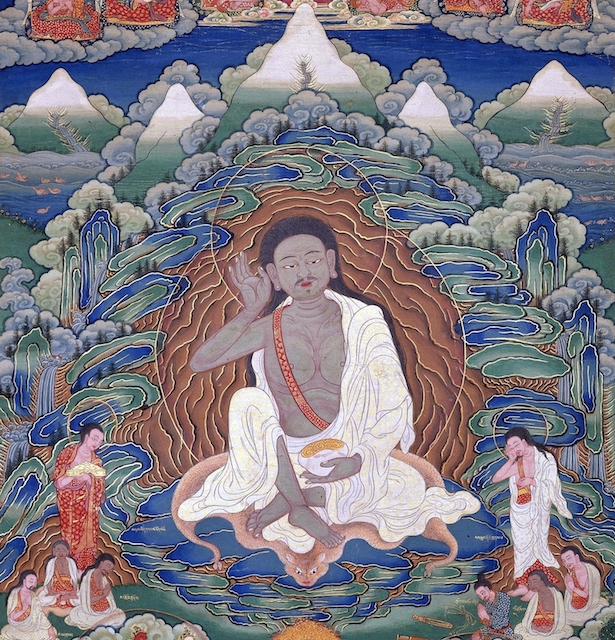The world seems to have gone mad. We all see it. We all feel it.
There is fear, panic, greed, overwhelm, and constant insecurity as everything we know is being called into question.
What can we do as individuals to not get bogged down in the mucky swamp of dense, heavy energy permeating the world? I get asked often how I prevent myself from getting trapped in the emotional quicksand of feeling the ever present suffering that tinges the very air we breath each day.
I’m so sensitive I can practically taste it, thus it would be quite simple for me to get sucked into the vortex of gloom, doom, and despair. However, I do not. And my trick is simple: Buddhist meditation and practices.
I jumped into meditation a few years back because, at the time, I realized I was standing at a critical crossroads in my life where essentially my choices were change or die. I chose change, and the following practices provided me with such a massive relief. They alleviated the anger, judgement, and overall abhorrence for the world that I held at the time. When I tapped into love and compassion, I started forgiving.
After all, at the time I was at war within myself, so how could I give peace to the world?
When we find love for ourselves, we also find peace. We find compassion, joy, and we begin to appreciate ourselves—flaws and all. This is how we will bring peace to the world and this is the only way I have come to know that allows me to stay afloat in a world that would have once drowned me in fear and overwhelm.
Tonglen Meditation (Taking and giving):
“Without attuning body, speech, and mind unto the Doctrine,
What gain is it to celebrate religious rites?
If anger be unconquered by its antidote,
What gain is it to celebrate religious rites?
Unless one meditates on loving others more than self,
What gain is it merely from the lips to say: ‘O, Pity (sentient beings)'”
~ Milarepa, Tibet’s Great Yogi Milarepa
When I first heard of tonglen meditation, I was in the middle of my 13th drug and alcohol rehab stint at the ripe age of 34 years old. I was almost completely devoid of hope, but a tiny spark remained within me. Pema Chodron’s book, The Places That Scare You fanned that little spark into a fire of hope and determination to reclaim my life. It was in this book that I found a written description of me and my lifelong struggles. And tonglen meditation was one of her recommendations for reducing our attachment and fear while tapping into our compassion—which by default would reduce aggression.
And boy, did I sure need to free myself of selfish attachment and aggression back then.
Needless to say, I started practicing tonglen and I began seeing results. I started softening and becoming less and less selfish. As I practiced breathing in the suffering of others and sending them back my own potential for freedom and happiness, I stopped fearing pain and suffering, and I began to have compassion for myself and others. I even softened toward my supposed “enemies.”
I still practice tonglen more than ever these days as a tool to stay afloat in the ocean of pain and suffering present on the planet right now. For a wonderful breakdown of how to begin a tonglen meditation, I suggest reading here.
Maitri (Loving-Kindness)
Maitri is a meditation practice that goes hand in hand with tonglen. The intention behind it is to cultivate love and compassion for ourselves and others. The reason this is so vital is because if we do not have love and compassion for ourselves then we cannot give these energies to the world. I was introduced to maitri at the same time as tonglen, and it played a crucial role in saving my life. I still practice this daily and it has unleashed an infinite well of divine love and compassion for myself and others.
It is suggested that you start with a mantra of some sort. That’s what I did in the start and still do. I use the following:
“May all beings be well. May they be happy. May they be healthy. May they be at peace. May they be free from pain and suffering.”
I repeat this three to five times as I focus on my breath. Then I move my focus to the following where I direct this peace mantra toward each of these people or groups of people, as I envision golden-white, glowing light surrounding each:
- First: Myself
- Second: Someone who has deeply cared for me that I love and respect in return.
- Third: A close friend or family member.
- Fourth: A neutral person—stranger, neighbor, grocery store clerk, someone I may or may not know.
- Fifth: Someone I dislike or have a conflict with.
- Sixth: All beings. I expand the feelings generated thus far to all beings in the world. I surround the Earth with the light and peace mantra.
I close with a simple chant of, “Om Mani Padme Om,” to invoke Chenrezig (a.k.a Avalokiteshvara), the embodiment of compassion.
Impermanence
Impermanence is the idea that all of conditioned existence, without exception, is transient, evanescent, inconstant.
“Buddhism declares that there are five processes on which no human being has control and which no one can ever change. These five processes are namely, the process of growing old, of not falling sick, of dying, of decay of things that are perishable and of the passing away of that which is liable to pass. Buddhism however suggests that escape from these is possible and it’s through Nirvana.”
Fighting any of these five processes is exactly what creates suffering. By default, suffering creates aggression. Accepting and embracing them creates joy and freedom. I never knew it was so simple. I spent a lifetime complicating all aspects of life. When I found this, I was exhausted.
I spent my whole life resisting all change. I thought if things would just be a certain way forever, life would be good, and I would be happy. If all would just go according to plan (my plan specifically), I would find and maintain happiness. I didn’t grasp that my plan might not be the bigger picture. I couldn’t comprehend that I wasn’t the ruler of the universe, so I stayed in lousy situations and jobs because I feared change and I didn’t trust.
“To put it concisely, we suffer when we resist the noble and irrefutable truth of impermanence and death.” ~ Pema Chödrön
When we accept that all the world is nothing but energy in constant motion manifesting in various ways, we can start to understand that nothing is forever. It’s our egoic need for stability and permanence that trips us up. We get so caught up in our idealism of how we believe the world should look, as well as our opinions of what is “right” and “wrong,” and all this does is keep us oppressed under an illusion of separation and a constant state of overwhelm.
When we step away from ego and our need to know and control, we find a space of freedom from the weight of the world because this too shall pass.
We can have faith in the ever shifting, dynamic energy that rules the universe.
We can’t save the world, and once we free ourselves from the illusion and grip of ego, we come to see this. What we can do is alleviate aggression and suffering within ourselves so that we can hold a space of love and compassion so as not to become prisoner of those who would hold us hostage with their fear, terror, and aggression.
May it be of benefit.
~
~
~
Author: Lindsay Carricarte
Image: Wikimedia
Editor: Travis May







Read 2 comments and reply